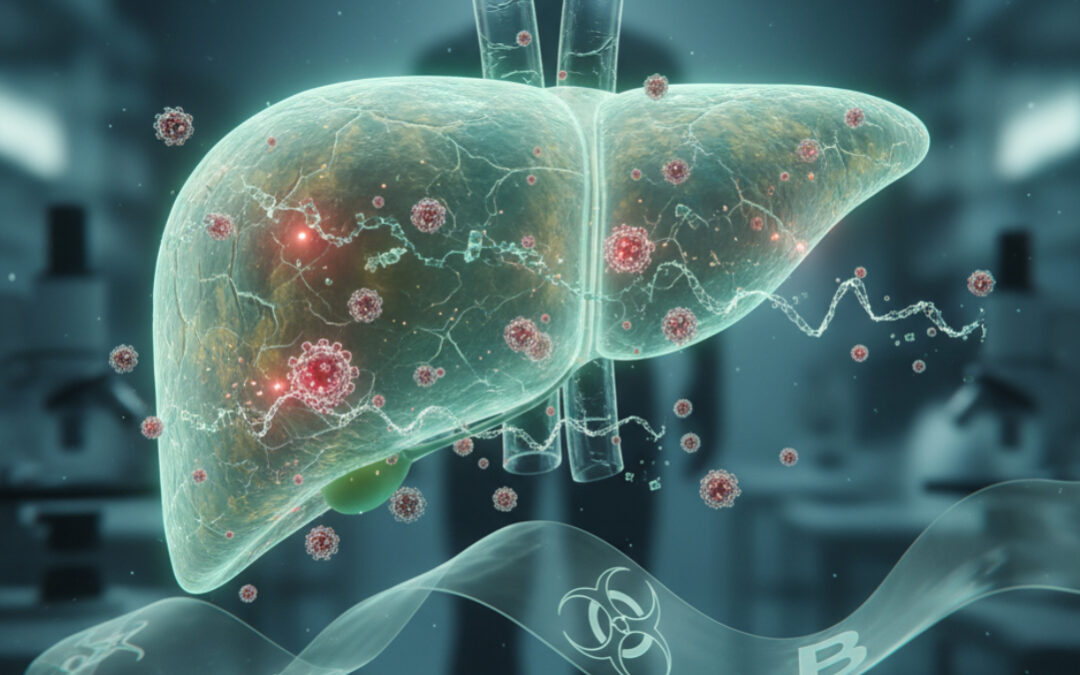ปรึกษาหมอกัณฒิภัสส์
?โรคไวรัสตับอักเสบบี (Hepatitis B) เป็นการติดเชื้อไวรัสที่ตับ ซึ่งอาจเป็นได้ทั้งแบบเฉียบพลัน (ระยะสั้น) และแบบเรื้อรัง (ระยะยาว) การติดเชื้อเรื้อรังเป็น “ภัยเงียบ” ที่น่ากลัว เพราะมักไม่มีอาการในระยะแรก แต่สามารถนำไปสู่ภาวะตับแข็ง มะเร็งตับ และอาจเสียชีวิตได้
✅ไวรัสตับอักเสบบีคืออะไร?
เป็นเชื้อไวรัสที่ติดต่อผ่านทางเลือด น้ำอสุจิ น้ำคัดหลั่งจากช่องคลอด และสารน้ำอื่นๆ ในร่างกายที่มีเชื้อไวรัส โดยช่องทางการติดต่อหลัก ได้แก่:
1. จากแม่สู่ลูก: เป็นช่องทางที่พบได้บ่อยที่สุด โดยเฉพาะอย่างยิ่งในช่วงคลอด ซึ่งกว่า 90% ของทารกที่ติดเชื้อจะกลายเป็นการติดเชื้อเรื้อรัง
2. เพศสัมพันธ์: การมีเพศสัมพันธ์โดยไม่ป้องกัน
3. การสัมผัสเลือด: การใช้เข็มฉีดยาร่วมกัน การสัก การเจาะตามร่างกายด้วยอุปกรณ์ที่ไม่สะอาด การใช้ของใช้ส่วนตัวร่วมกับผู้ติดเชื้อ เช่น มีดโกน แปรงสีฟัน
?อาการเป็นอย่างไร?
• ไวรัสตับอักเสบบีเฉียบพลัน: ผู้ป่วยส่วนใหญ่มักไม่มีอาการ หรือมีอาการคล้ายไข้หวัด เช่น อ่อนเพลีย เบื่ออาหาร คลื่นไส้ อาเจียน อาจมีไข้ต่ำๆ ปวดท้องเล็กน้อย และบางรายมีอาการตัวเหลือง ตาเหลือง ปัสสาวะสีเข้ม (ดีซ่าน) ส่วนใหญ่มักหายได้เองภายใน 6 เดือน
• ไวรัสตับอักเสบบีเรื้อรัง: มักไม่มีอาการชัดเจนในระยะแรก ทำให้ผู้ติดเชื้อหลายคนไม่รู้ตัว การตรวจพบมักเกิดจากการตรวจสุขภาพประจำปีหรือเมื่อเริ่มมีภาวะตับแข็งหรือมะเร็งตับแล้ว
✅การป้องกันที่ดีที่สุดคืออะไร?
คือ การฉีดวัคซีนป้องกันไวรัสตับอักเสบบี ซึ่งมีความปลอดภัยและมีประสิทธิภาพสูง
• แนะนำให้ฉีดวัคซีนตั้งแต่แรกเกิดและให้ครบตามกำหนด
• ผู้ที่ยังไม่เคยได้รับวัคซีนและยังไม่มีภูมิคุ้มกัน ควรรับการฉีดวัคซีนให้ครบ
• การป้องกันการติดเชื้อผ่านช่องทางอื่น ๆ เช่น การมีเพศสัมพันธ์ที่ปลอดภัย การไม่ใช้เข็มฉีดยาหรือของใช้ส่วนตัวร่วมกับผู้อื่น ก็มีความสำคัญ
?การวินิจฉัยและการติดตามผล
การวินิจฉัยทำได้ด้วยการตรวจเลือด โดยดูจากเครื่องหมายทางซีรั่มวิทยา (Serological Markers) ที่สำคัญคือ HBsAg (Hepatitis B Surface Antigen) เพื่อยืนยันว่ามีการติดเชื้อ (ทั้งเฉียบพลันและเรื้อรัง) และ HBeAg (Hepatitis B e Antigen) เพื่อประเมินระดับการแบ่งตัวของไวรัส
ผู้ป่วยที่มีการติดเชื้อเรื้อรังไม่จำเป็นต้องได้รับการรักษาด้วยยาต้านไวรัสทุกคน แพทย์จะพิจารณาจากปัจจัยหลายอย่าง ได้แก่:
1. ระดับเอนไซม์ตับ (ALT/AST): แสดงถึงการอักเสบของตับ
2. ปริมาณไวรัสในเลือด (HBV DNA): ระดับที่สูงบ่งชี้ถึงการแบ่งตัวของไวรัส
3. ความรุนแรงของโรคตับ: ประเมินจากภาวะตับแข็ง (Cirrhosis) หรือพังผืดในตับ (Fibrosis)
แนวทางการรักษา
เป้าหมายหลักของการรักษาโรคไวรัสตับอักเสบบีเรื้อรังคือ การลดการแบ่งตัวของไวรัส (HBV DNA) และลดการอักเสบของตับ เพื่อป้องกันหรือชะลอการเกิดภาวะตับแข็งและมะเร็งตับ
ยาต้านไวรัสชนิดรับประทาน (Oral Antivirals )
• ยาหลักที่ใช้ในปัจจุบัน เช่น Entecavir และ Tenofovir (TDF, TAF): เป็นยาที่มีประสิทธิภาพสูงในการยับยั้งไวรัส โอกาสดื้อยาน้อย และมีผลข้างเคียงที่ยอมรับได้
• ผู้ป่วยส่วนใหญ่ที่ต้องเริ่มการรักษาด้วยยากลุ่มนี้ มักจะต้องรับประทานยาอย่างต่อเนื่องเป็นระยะเวลานาน (อาจตลอดชีวิต) เพื่อควบคุมเชื้อไวรัส เนื่องจากยาในปัจจุบันยังไม่สามารถกำจัดไวรัสออกจากร่างกายได้อย่างสมบูรณ์ แต่สามารถลดความเสียหายต่อตับได้อย่างมีนัยสำคัญ
❤️การติดตามและการดูแลตนเอง
ผู้ป่วยไวรัสตับอักเสบบีเรื้อรังทุกคนควรได้รับการติดตามจากแพทย์อย่างสม่ำเสมอทุก 3-6 เดือน เพื่อตรวจเอนไซม์ตับ ปริมาณไวรัส และตรวจคัดกรองมะเร็งตับด้วยอัลตราซาวนด์ตับ (Ultrasound) ร่วมกับการตรวจเลือด AFP (Alpha-Fetoprotein)
??ข้อปฏิบัติสำหรับผู้ป่วย:
• งดแอลกอฮอล์โดยเด็ดขาด
• หลีกเลี่ยงการใช้ยาชุด ยาสมุนไพรที่ไม่ทราบส่วนประกอบ ซึ่งอาจเป็นพิษต่อตับ
• รับประทานยาตามที่แพทย์สั่งอย่างเคร่งครัด ห้ามหยุดยาเอง
• รับการฉีดวัคซีนป้องกันไวรัสตับอักเสบเอ (Hepatitis A) เพื่อป้องกันการติดเชื้อซ้ำซ้อน
?การรับรู้ถึงความเสี่ยง การตรวจคัดกรอง การป้องกันด้วยวัคซีน และการเข้ารับการรักษาที่เหมาะสมตามคำแนะนำของแพทย์ เป็นกุญแจสำคัญในการลดอันตรายจากโรคไวรัสตับอักเสบบี
โทร 0833309366
เปิดทุกวัน
จันทร์ ถึง พุธ 16.30 – 20.00 น.
พฤหัส ถึง ศุกร์. 8.00 – 20.00 น.
วันเสาร์ 8.00 – 12.00 น.
อาทิตย์ 8.00 – 16.00 น.
Monday – Wednesday 4.30 pm to 8 pm
Thursday – Friday 8 am to 8 pm
Saturday 8 am to noon
Sunday 8 am to 4 pm
แผนที่ google map กดที่ลิ้ง http ได้เลยครับ
https://maps.app.goo.gl/8q59d
+++++++++++++++++++++++++++++++++++++
Hepatitis B is a viral liver infection that can be acute (short-term) or chronic (long-term). Chronic infection is a frightening “silent threat” because it often has no symptoms in the early stages, but can lead to cirrhosis, liver cancer, and even death.
✅What is Hepatitis B?
It is a virus transmitted through blood, semen, vaginal fluids, and other body fluids that contain the virus. The main transmission routes include:
1. Mother-to-child: This is the most common route, especially during childbirth. Over 90% of infected infants develop chronic infection.
2. Sexual intercourse: Unprotected sex.
3. Blood contact: Sharing needles, tattooing, body piercing with unclean equipment, and sharing personal items with infected individuals, such as razors and toothbrushes.
?What are the symptoms?
• Acute Hepatitis B: Most patients are asymptomatic or experience flu-like symptoms, such as fatigue, loss of appetite, nausea, vomiting, and may experience a low-grade fever and mild abdominal pain. Some people also experience jaundice (yellowing of the skin, eyes, and dark urine). Most cases resolve on their own within six months.
• Chronic Hepatitis B: Symptoms are often not obvious in the early stages, leading many infected individuals to be unaware. Detection is usually achieved through annual health checkups or when cirrhosis or liver cancer develops.
✅ What is the best prevention?
Hepatitis B vaccination is safe and highly effective.
• Vaccination is recommended at birth and as scheduled.
• Those who have not been vaccinated and are not yet immune should receive the full vaccination.
• Preventing infection through other routes, such as practicing safe sex and avoiding sharing needles or personal items, is also important.
?Diagnosis and Follow-up
Diagnosis is performed using blood tests, looking at key serological markers: HBsAg (Hepatitis B Surface Antigen) to confirm infection (both acute and chronic), and HBeAg (Hepatitis B e Antigen) to assess the level of virus replication.
Not all patients with chronic infection need to be treated with antiviral drugs. Doctors will consider several factors, including:
1. Liver enzyme levels (ALT/AST): Indicates liver inflammation.
2. Viral load (HBV DNA): High levels indicate viral replication.
3. Severity of liver disease: Evaluated by cirrhosis or fibrosis.
Treatment Approach
The primary goal of treatment for chronic hepatitis B is to reduce viral replication (HBV DNA) and liver inflammation to prevent or delay the development of cirrhosis and liver cancer.
Oral Antivirals
• Current mainstay medications, such as Entecavir and Tenofovir (TDF, TAF): These are highly effective in suppressing the virus, have a low chance of resistance, and have acceptable side effects.
• Most patients who begin treatment with these medications typically require long-term (possibly lifelong) adherence to the medication to control the virus. Current medications cannot completely eliminate the virus from the body, but they can significantly reduce liver damage.
❤️Monitoring and Self-Care
All patients with chronic hepatitis B should receive regular follow-up with their doctor every 3-6 months to monitor liver enzymes, viral load, and screen for liver cancer using an ultrasound and an AFP (Alpha-Fetoprotein) blood test.
??Patient Instructions:
• Absolutely abstain from alcohol.
• Avoid prescription medications and herbal remedies with unknown ingredients, which may be toxic to the liver.
• Take medications strictly as prescribed by your doctor. Do not stop taking them on your own.
• Get vaccinated against hepatitis A to prevent secondary infection.
?Risk awareness, screening, vaccination, and appropriate treatment as recommended by your doctor are key to reducing the risk of hepatitis B infection.



